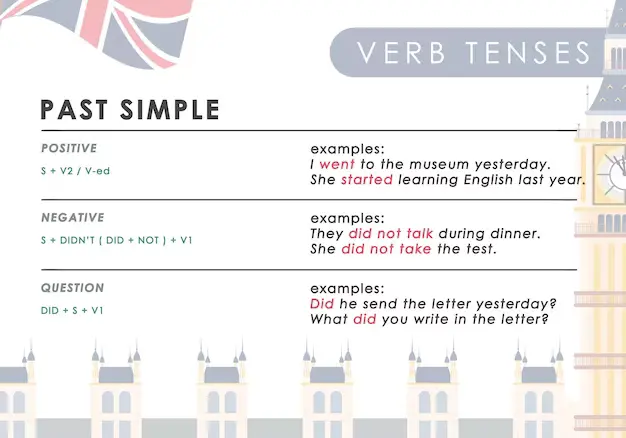
With most verbs, the past tense is formed by adding –ed:
| Call called | Like liked | Want wanted | Work worked |
But there are a lot of irregular past tense forms in English. for example:
| Base form | Past tense |
|---|---|
| be begin break bring buy build choose come cost cut do draw drive eat feel find get give go have hear hold keep know leave lead let lie lose make mean meet pay put run say sell send set sit speak spend stand take teach tell think understand wear win write | was/were began broke brought bought built chose came cost cut did drew drove ate felt found got gave went had heard held kept knew left led let lay lost made meant met paid put ran said sold sent set sat spoke spent stood took taught told thought understood wore won wrote |
The simple past tense

Have you ever learned the simple past tense? If not, don’t worry. This article on simple past tense will help you understand the meaning, definition and structure of simple past tense. Additionally, you will also learn how to use the simple past tense and its uses, accompanied by examples.
Simple past tense: Definition
The simple past tense, according to the Cambridge Dictionary, is defined as “the form of a verb used to describe an action which occurred before the present time and which no longer takes place. It is usually formed by adding -ed .” The Collins Dictionary defines the simple past tense as “a tense used to refer to the past.” The Macmillan Dictionary defines the simple past tense as “the tense used to talk about habitual actions, behaviors, or situations that happened or existed before now.”
Simple past tense structure
The structure of the simple past tense can be easily understood by analyzing how this tense is used in positive, negative, interrogative, and negative interrogative formats. Look at the table below to understand better.
Structure of the simple past tense:
| Shape | Positive | Negative |
|---|---|---|
| Subject + Verb in the past tense (verb in the infinitive + ed/d for regular verbs or past tense form of irregular verbs) | Subject + didn’t + Verb in the infinitive | Did + Subject + Verb to infinitive |
| Example | You spoke very well. | I didn’t have breakfast. |
Rules and points to remember when using the simple past tense
Use of simple past tense
The simple past tense can be used to:
- Referring to a past action or event.
- Talking about something that was true for some time in the past.
- Explain something that has happened several times in the past.
Formation of the simple past tense – Examples
To help you understand how to use the simple past tense, here are some examples:
- Reference to a past action:
- We went to the park last night.
- I completely forgot about the meeting.
- Manu opened the door for the guests.
- True action for some time in the past:
- Karthik used to play tennis when he was in school.
- Miss Holly was working as a guest lecturer in our college.
- Santana loved reading fantasy novels when she was younger.
- Action that has happened several times in the past:
- I worked as an educational advisor for six months.
- We enjoyed playing Pictionary every time we got together.
- My father dropped me off at school every day until I started high school.
Test Your Understanding of Simple Past Tense
Fill in the blanks with the simple past tense of the verbs mentioned in the brackets:
1. I _____ (pay) the bills already.
2. The teacher ________ (motivate) her kids to stand up for themselves and their fellow classmates.
3. Reena ______ (to be) a student at Delhi University.
4. ______ you ______ (finish – interrogative) the science and maths assignments?
5. Tina __________ (know – negative) about yesterday’s test.
6. _________ he ________ (complete – negative interrogative) the paper yet?
7. Rahul __________ (play) basketball in college.
8. Will and Emma _________ (to be) at the fair.
9. Manish _________ (sell) all the sachets.
10. I _________ (think) about it, but I don’t think it will work.
Check out if you filled in the blanks with the right form of the verb.
1. I paid the bills already.
2. The teacher motivated her kids to stand up for themselves and their fellow classmates.
3. Reena was a student at Delhi University.
4. Did you finish the science and maths assignments?
5. Tina did not know about yesterday’s test.
6. Didn’t he complete the paper yet?
7. Rahul played basketball in college.
8. Will and Emma were at the fair.
9. Manish sold all the sachets.
10. I thought about it, but I don’t think it will work.
FAQ the simple past tense in English
Q1 What is the past simple? The simple past tense is a tense used to represent an action or event that happened in the past. With many verbs, the simple past tense is formed by adding “-ed” or “-d” to the end of the verb in the infinitive. However, there are other verbs that behave differently and take on different spellings when used in the simple past tense.
Q2 What is the definition of past simple? The simple past tense is defined as “the form of a verb used to describe an action that occurred before the present moment and no longer occurs. It is usually formed by adding -ed.” according to the Cambridge dictionary. The Collins Dictionary defines it as “a tense used to refer to the past” and the Macmillan Dictionary defines it as “the tense used to talk about habitual actions, behaviors, or situations that happened or existed before now.”
Q3 What is the simple past tense formula? The basic formula for the simple past tense is as follows: Subject + verb in the past tense (verb in the infinitive + ed/d for regular verbs)
Q4 Give some examples of the simple past tense. Here are some examples to show you how the past simple is used in sentences:
- We went to the park last night.
- My father dropped me off at school every day until I started high school.
- Santana loved reading fantasy novels when she was younger.
- I worked as an educational advisor for six months.
conclusion
The simple past tense is used to describe actions that happened in the past. It is formed by adding “-ed” or “-d” to the end of the verb in the infinitive for regular verbs, while irregular verbs follow different spelling patterns. The simple past tense can be used to refer to a past action, talk about something that was true in the past, and explain actions that have happened more than once.





